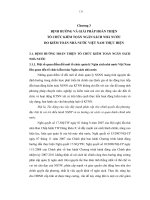Bài giảng Phương pháp nghiên cứu định tính - PGS.TS.BS. Lê Hoàng Ninh
Bạn đang xem bản rút gọn của tài liệu. Xem và tải ngay bản đầy đủ của tài liệu tại đây (4.74 MB, 26 trang )
______________________________________
PHƢƠNG PHÁP
NGHIÊN CỨU
ĐỊNH TÍNH
____________________________________________
GS TS BS LÊ HỒNG NINH
DỮ LiỆU TRONG
NGHIÊN CỨU ĐỊNH TÍNH
Dữ liệu định tính là dữ liệu mà khơng / khó
d0o lƣờng bằng các số đo, số đếm hay một chữ
số nào đó.
Kiểu dữ liệu nầy đƣợc dùng trong nghiên cứu
khai thác chi tiết, mô tả các đặc trƣng bàng lời
nói, tình huống cụ thể, hay một nơi cụ thể nào
đó
Dữ liệu trong n.c định tính
Data có thể đƣợc xếp theo nhiều thể cách khác
nhau nhƣng không thể biểu thị bằng số đo là
con số.
Data that is not quantitative
Tính ứng dụng của nc định tính
The question is not whether to use qualitative
methods in IS, since they are always used in
some way. The question is how systematic
should their application be.
Qualitative Research
What are qualitative data?
Where do we get them and how? How do we
analyze them?
Why should they be used in IS and how?
Qualitative IS design issues.
Basic Methods
Individual Interviews
Focus groups
Direct Observation
Participant-Observation
Software: What it does and doesn’t do
Atlas.ti
NVivo/Nud*ist
CDC EZ text
Anthropac
Ryan 2004
Why and how should we use
qualitative methods in IS ?
Mixing Methods/Qual-quant
Three purposes (Sandelowski):
Triangulation – convergent validation
Complementarity – clarify, explain, elaborate
Development – guide additional data collection
Priority Decision
Quantitative
Comp
Prelim
Qualitative
Qualitative Preliminary
Qual
QUANT
Quantitative Preliminary
Quant
QUAL
Qualitative follow-up
QUANT
Qual
Quantitative follow-up
QUAL
Quant
Sequence
Decision
Comp
Follow-up
Morgan
Steps in the IS/OR Process
1. Identify and diagnose the problem
2. Generate a programmatic solution to solve
problem
3. Design and test intervention to solve the
problem
4. Ensure results are used
5. Disseminate results
Example: Loss to Follow-up from HIV
testing to HAART in Mozambique
Flow through the HIV care system in Beira and Chimoio, Mozambique, Jun
04 - Sept 05
700
HIV+
Average patients per month
600
500
400
300
200
100
0
Enroll at HIV clinic
(59%)
Undergo CD4 testing
(78%)
Eligible for HAART
(48%)
Start HAART (46%)
Good IS/OR views health programs as
interdependent “systems” (2)
Local level HIV care system in Mozambique
Testing center
HIV
testing
HIV clinic
Enroll at
HIV clinic
Undergo
CD4 testing
Start
HAART, if
eligible
Adhere to
HAART
– How can we change the system to improve the flow?
– Will improving one step affect other steps?
Health programs are complex systems
HIV
testing
Arrives at
HIV clinic,
sees
receptionist
Enroll at
HIV clinic
Schedules
doctor
appointment
Undergo
CD4 testing
Start
HAART, if
eligible
Doctor
orders CD4
Time &
drop-off
Potential solutions
CD4 ordered by non-doctors, at enrollment?
All blood draws same-day?
CD4 ordered in HIV testing site?
Move CD4s to another site?
Time &
drop-off
Adhere to
HAART
Blood drawn
for CD4
(sometimes
next-day)
Problems & solutions
depend on system
•Staffing
•Lab location, capacity,
policies
1. Identify and diagnose the problem
How much of problem derives
from patient characteristics
vs. system problems?
Qualitative research approaches:
- Direct observation
- Focus group discussions
- Individual interviews with
health workers/target pop.
- Map flow from perspective of
patients
Why mix methods?
Triangulation – convergent validation
Complementarity – clarify, explain, elaborate
Development – guide additional data collection
2. Generate a programmatic solution to solve problem
Qualitative research approaches:
- Focus group discussions
- Participatory Action Research
- Individual interviews with health workers/target pop
Examples: Potential systemic solutions
- CD4 ordered by non-doctors, at enrollment
- All blood draws same-day
- CD4 ordered in HIV testing site
- Move CD4s to another site
- Improved health worker training
- Improved counseling
Examples: Potential community-based solutions
- Improved education about testing and treatment.
- Community mobilization strategies for social support.
3. Design and test intervention to solve the problem
- Process: Individual interviewing and direct observation
for regular process monitoring and evaluation, and for
identification of unintended consequences of
intervention.
- Impact: Interviews, focus groups, observation combined
with quantitative measures to test intervention
effectiveness and impact.
4. Ensure results are used:
New research question: How to influence policymakers and
program managers?:
- Interviews with leaders
- Focus groups with HWs
- Examine policy documents
5. Disseminate results:
Identify best venues for dissemination to influence policy
and generate discussion through analysis of data gathered
using methods above.









